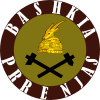Përrenjas
|
Përrenjas Përrenjasi |
||

|
||
|
Coordinates: 41 ° 4 ′ N , 20 ° 33 ′ E |
||
| Basic data | ||
|---|---|---|
| Qark : | Elbasan | |
| Municipality : | Përrenjas | |
| Height : | 590 m above sea level A. | |
| Area : | 322.95 km² | |
| Bashkia residents : | 24,906 (2011) | |
| Population density (Bashkia): | 77 inhabitants / km² | |
| Telephone code : | (+355) 591 | |
| Postal code : | 3403-3404 | |
| Politics and administration (as of 2019 ) | ||
| Mayor : | Nuri Belba ( PS ) | |
| Website : | ||
| Culture and history | ||
| Local place name : | Prrenjas / Prrenjasi | |
 Town center on the national road in 1995 and 2013 |
||
Përrenjas ( Albanian also Përrenjasi and often Prrenjas or Prrenjasi ) is a small town in eastern Albania . The mining town in Librazhd County is not far from the North Macedonian border and has 5847 inhabitants.
Përrenjas is located on the western ascent to the Qafë Thana pass ( 937 m above sea level ) in a small plain, the Fusha e Domosdovës , surrounded by mountains over 1000 meters high at almost 600 m above sea level. A. The plain, a large karst doline , is drained west to Shkumbin by the Lingjaca River. In the east lies the pass, which is also the transition to Lake Ohrid and where the border crossing to North Macedonia is located. A little to the north is the Shebenik mountain range, part of the Shebenik-Jablanica National Park , to the south the Mokra Mountains .
In the summer of 2015, the municipality was merged with the surrounding municipalities ( komuna ) in the south of the repealed Librazhd district , with Qukës (8211 inhabitants), Rrajca (8421 inhabitants) and Stravaj (2427 inhabitants). Qukës is located in the Shkumbin Valley west of Përrenjas, Stravaj even further south-west, Rrajca borders Përrenjas to the east. The new municipality has 24,906 inhabitants (as of 2011).
The old community - whose authorities stated a population of 8256 people (2007) - with an area of 1830 hectares still included the villages of Fshat Përrenjas (Përrenjas village) with around 1500 inhabitants and Rashtan with around 600 inhabitants.
Today the SH 3 , which connects Elbasan with Pogradec , runs through Përrenjas and over the pass. The Romans ran along the Via Egnatia here , the important connection between the ports on the eastern shore of the Adriatic and Constantinople . The Ottomans later moved along this route and were hit hard for the first time by Skanderbeg in 1444 . The important transport connection, the main road to south-eastern Bania, has been well developed in recent years, as Pan-European Transport Corridor VIII, also with European support. Since 1974 a railway line of the Hekurudha Shqiptare leads to Përrenjas, which five years later was extended to Pogradec.
In the late 1960s and early 1970s, larger mines were built in Përrenjas, which mainly supplied the steel mill in Elbasan. The city was founded in 1953 as accommodation for the residents of the northwestern mine of Pishkash and received the name of the nearby village. Iron and nickel were mined in opencast and underground mines , some of which was also processed on site. Most of the mining activities have been discontinued since the end of the 1990s, but chromium is still to be mined in cooperation with an Italian company .
The Domosdova plain is good agricultural land and agriculture is one of the most important branches of employment with an area of over 550 hectares. The place is the regional center between Librazhd and Pogradec. It has a small hospital and training facilities such as a middle school with around 400 students.
Web links
- Official website of the Bashkia (Albanian)
Individual evidence
- ↑ a b Ines Nurja: Censusi i popullsisë dhe banesave / Population and Housing Census - Elbasan 2011 . Results Kryesore / Main Results. Ed .: INSTAT . Pjesa / Part 1. Adel Print, Tirana 2013 ( document as PDF [accessed on April 28, 2019]).
- ^ A b Ralph-Raymond Braun: Albania - travel manual and country studies . Unterwegsverlag, Rielasingen 1988, ISBN 3-924334-18-8 .
- ↑ Popullsia. In: Qarku i Elbasanit. Retrieved March 16, 2012 (Albanian).
- ↑ a b Bashkia Prrenjas. Archived from the original on July 7, 2011 ; Retrieved March 14, 2012 (Albanian).
- ↑ a b c Bashkia Prrenjas. In: Qarku i Elbasanit. Retrieved March 16, 2012 (Albanian).
- ↑ a b c James Pettifer: Albania & Kosovo - Blue Guide . A & C Black, London 2001, ISBN 0-7136-5016-8 .
- ^ I. Nako, V. Jorgji, A. Bakiu: Albanian mineral industry and its trends in the future . In: GN Panagiotou, TN Michalakopoulos (Ed.): Mine Planning and Equipment Selection 2000 . Taylor & Francis, Rotterdam 2000, ISBN 978-90-5809-178-9 , pp. 463 .
- ^ Nickel in Albania. (PDF) (No longer available online.) In: Ministry of Economy, Trade and Energy. 2009, formerly in the original ; Retrieved March 15, 2012 . ( Page no longer available , search in web archives )
- ^ Activity economics. In: Qarku i Elbasanit. Retrieved March 16, 2012 (Albanian).
- ↑ Bashkia Prrenjas. Archived from the original on July 7, 2011 ; Retrieved March 14, 2012 (Albanian).

